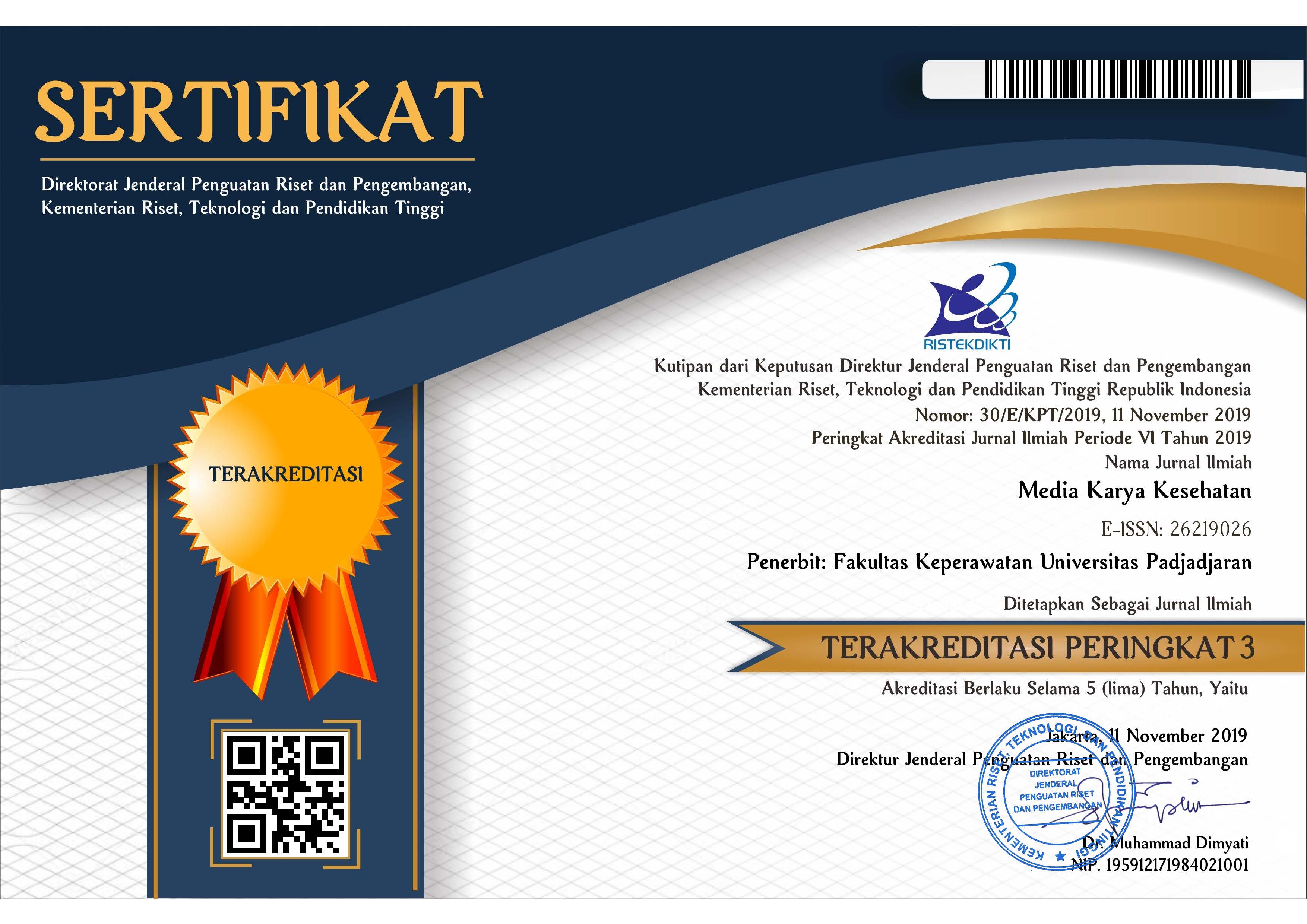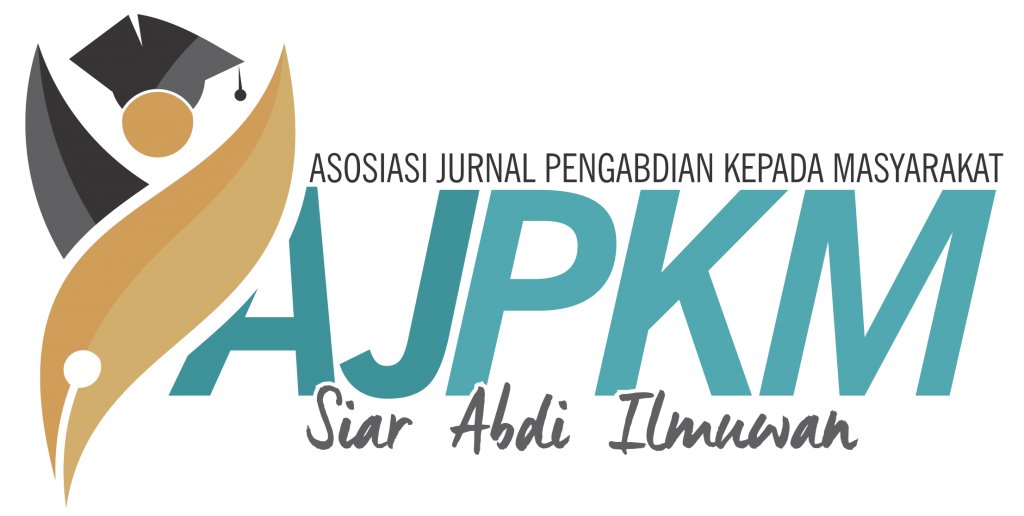Online Submissions
Already have a Username/Password for Media Karya Kesehatan?
Go to Login
Need a Username/Password?
Go to Registration
Registration and login are required to submit items online and to check the status of current submissions.
Author Guidelines
SCIENTIFIC ARTICLE WRITING FORMAT
OF MEDIA KARYA KESEHATAN (MKK)
- GENERAL PROVISIONS
- The article is the results of Community Service (Pengabdian Pada Masyarakat-PPM) activities or research activities integrated with community service.
- The article has never been published, is not in the process of being reviewed in another journal, nor is it in the accepted status for publication.
- The article is typed with line spacing 1.5, Times New Roman font size 12, using quarto paper (A4).
- The article is written in Indonesian or English.
- The article consists of 15-20 pages, including references and attachments.
- The article is accompanied by a statement from the Author that the article is genuinely his/her work, and does not contain elements of plagiarism, written on stamped paper and signed by the Author.
- The article is sent in softcopy using the Word Microsoft application to email http://jurnal.unpad.ac.id/mkk.
- STRUCTURE OF WRITING
- The title consists of a maximum of 15 words (Times New Roman font size 14).
- The name of the institution accompanies the Author’s name (without an academic degree), Corresponding/first author include an email address.
- An abstract written in Indonesian and English consists of a single paragraph with one-line spacing using Times New Roman letters font size 10. The abstract consists of a maximum of 250 words. The abstract clearly explains the subject matter, objectives, methods, results, discussion, and conclusions. Keywords are written in Indonesian and English (3-7 words each).
- The introduction contains:
- Background of the implementation of the PPM activities.
- Describe the actual and factual issues, problems, challenges, and community needs associated with the target activity.
- Literature study.
- Efforts that have been made by the PPM team or other parties.
- The purpose of PPM activities.
- The introduction must be described in narrative rather than pointer form, and written in Times New Roman font size 11, without footnotes.
- The method contains a description of the technique of implementing activities or ways to resolve PPM challenges, as well as the issues or basic needs targeted by PPM activities
- Methods used in PPM are as follows: Community Education: used for activities, for example :
- Training, such as in-house training.
- Counseling aims at things like increasing understanding and awareness
- Consultation: used for activities in which problems or needs in the community are solved through synergism with universities.
- Science and Technology Diffusion: used for activities that produce products for consumers.
- Training:
- Training on the substance of activities accompanied by demonstrations or pilots for their realization;
- Training in operating systems or equipment.
- Formation of new entrepreneurial groups.
- Provision of certified services to the public.
- Mediation: used for PPM activities that position themselves as mediators for related parties and jointly resolve existing problems in the community.
- Science and Technology Simulation: used for PPM activities where the main task is to establish an information system that aims to explain things that are not applicable in practice.
- Science and Technology Substitution: Used for activities that offer new science and technology which is more modern and efficient than the old science and technology (Science in the form of Appropriate Technology – TTG/Teknologi Tepat Guna).
- Advocacy: Used for PPM activities in the form of assistance to the community.
- Other methods.
- Methods used in PPM are as follows: Community Education: used for activities, for example :
- The results contain findings in the form of statements, tables, diagrams, and graphs. This section includes the main sub-results, written systematically.
- Tingkat ketercapaian target kegiatan di lapangan.
- Ketepatan/kesesuaian antara masalah dan kebutuhan/tantangan yang dihadapi dengan metode yang diterapkan.
- Dampak dan manfaat kegiatan.
- Rekomendasi untuk kegiatan PPM selanjutnya
- The discussion contains a debate between the results of the PPM with an analysis of activities based on the study of the theory used. This section includes the main discussion, which is systematically written.:
- Ucapan terimakasih ditulis satu paragraf.
- Daftar pustaka ditulis berdasarkan model APA (American Psychological Association)
Contoh penulisan Daftar Pustaka:
BKKBN. (2012). Pedoman Pengelolaan Pusat Informasi dan Konseling Remaja dan Mahasiswa. Jakarta: Direktorat Bina Ketahanan Remaja.
Subroto, E., Tensiska, dan Indiarto. R. (2014). Peningkatan Pengetahuan dan Keterampilan dalam upaya Mendukung Ketahanan Pangan di Desa Girijaya dan Mekarjaya, Kecamatan Cikajang, Kabupaten Garut. Dharmakarya. 13(1) ; 1─4.
Pemerintah Kabupaten Bandung (2014). Pemkab Bandung Dan KPA Sabilulungan Perangi AIDS. http://www.bandungkab.go.id/arsip/3566/pemkab-bandung-dan-kpa-sabilulungan-perangi-aids. Diakses tanggal 6 Januari 2016.
Wijana, I.D.P. (2007). Bias Gender pada Bahasa Majalah Remaja. Tesis, Fakultas Ilmu Budaya. Yogyakarta: Universitas Gadjah Mada.
JURNAL INI TERINDEKS DI:









Penerbit :
Fakultas Keperawatan, Universitas Padjadjaran
Jalan Raya Bandung-Sumedang Km. 21 Jatinangor, Sumedang, Indonesia 45363
WA: 085317736810
Tlp. 022-7795596
Email: info.mkk.keperawatan@unpad.ac.id
Email: novita.trivita@gmail.com

This work is licensed under a Creative Commons Attribution-NonCommercial 4.0 International License



